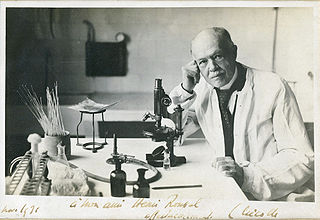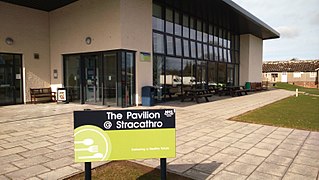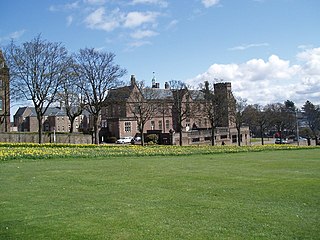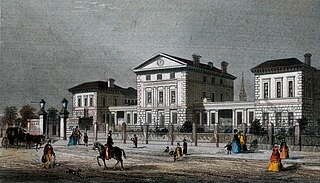History
King's Cross opened in November 1889 at a site in Clepington Road, Dundee. It was the city's first permanent fever hospital and was built by Dundee Town Council to treat patients with infectious diseases, including typhus, diphtheria and smallpox. Until the late 1860s, such patients had usually been admitted to Dundee Royal Infirmary, although a temporary fever hospital had been set up in a converted building in Lower Union Street during the 1832 cholera outbreak. [1] [2]
As the need for isolation of patients with infectious diseases became more widely recognised, some temporary wooden pavilions were built on the outskirts of Lochee in 1867 and later on the site of what is now King's Cross for smallpox and typhus patients. Kings Cross, which initially had just two wards, took over their function. [1] [3] By 1913 King's Cross had seven wards supplemented by several a variety of ancillary buildings. These included King's Cross Hospital (West), built in 1893 as accommodation for cases of smallpox, with a small unit for cholera patients. These facilities were used intermittently until 1927 when the hospital had address an outbreak of variola minor. This outbreak was severe enough to require an additional ward to be constructed. [1]
At the creation of the National Health Service in 1948, King's Cross came under the management of the new Eastern Regional Hospital Board and was run by Dundee General Hospitals Board of Management. [1] [4] The Eastern Regional Hospital Board decided to centralise the management of infectious disease at King's Cross, resulting in the closure the former fever hospitals at Perth, Forfar and Arbroath. [1] In 1988 work began on a new out-patient department. [3] Since the 1990s most of the hospital's services have been transferred to Ninewells Hospital. King's Cross now serves as the administrative headquarters of NHS Tayside. The hospital is also the site of NHS Tayside's Kings Cross Health and Community Care Centre, which offers several outpatient services including audiology, physiotherapy, dentistry and x-ray and is also the base for Dundee's "Out of Hours GP Service". [1] [5]
The King's Cross Hospital archives are held by Archive Services at the University of Dundee as part of the NHS Tayside Archives. [1] The same institution also holds the papers of Dr William Maxwell Jamieson OBE who worked at the hospital from 1939 until 1979 and became its Physician Superintendent in 1948. These papers include several records relating to the hospital and its history. [6] A history of the hospital by Jamieson was produced in 1989 to mark its centenary. [3]

Charles Jules Henri Nicolle was a French bacteriologist who received the Nobel Prize in Medicine for his identification of lice as the transmitter of epidemic typhus.
The UK statutory notification system for infectious diseases is a system whereby doctors are required to notify a "proper officer" of the local authority if they are presented with a case of a serious infectious disease such as diphtheria or measles. The proper officer then sends a report to the Centre for Infections of the Health Protection Agency (HPA) in Colindale, north London.
Dundee is the fourth-largest city in Scotland with a population of around 150,000 people. It is situated on the north bank of the Firth of Tay on the east coast of the Central Lowlands of Scotland. The Dundee area has been settled since the Mesolithic with evidence of Pictish habitation beginning in the Iron Age. During the Medieval Era the city became a prominent trading port and was the site of many battles. Throughout the Industrial Revolution, the local jute industry caused the city to grow rapidly. In this period, Dundee also gained prominence due to its marmalade industry and its journalism, giving Dundee its epithet as the city of "jute, jam and journalism".

Ninewells Hospital is a large teaching hospital, based on the western edge of Dundee, Scotland. It is internationally renowned for introducing laparoscopic surgery to the UK as well as being a leading centre in developing fields such as the management of cancer, medical genetics and robotic surgery. Within the UK, it is also a major NHS facility for psychosurgery. The medical school was ranked first in the UK in 2009. The hospital has nursing and research links with the University of Dundee and is managed by NHS Tayside.

Sunnyside Royal Hospital was a psychiatric hospital located in Hillside, north of Montrose, Scotland. It closed in 2011 and is now used for housing.

NHS Tayside is an NHS board which forms one of the fourteen regions of NHS Scotland. It provides healthcare services in Angus, the Dundee City council area and Perth and Kinross. NHS Tayside is headquartered at Ninewells Hospital in Dundee; one of the largest hospitals in the world.

Stracathro Hospital is a community hospital in Angus, Scotland. Established as a wartime Emergency Hospital Service facility during the Second World War, it was afterward developed as a District General Hospital. Since 2005 it has been the site of the Scottish Regional Treatment Centre.

Arbroath Infirmary is a hospital at the top of Rosemount Road in Arbroath serving the town and the greater area of Angus, Scotland. The hospital is managed by NHS Tayside.

Dundee Royal Infirmary, often shortened to DRI, was a major teaching hospital in Dundee, Scotland. Until the opening of Ninewells Hospital in 1974, Dundee Royal Infirmary was Dundee's main hospital. It was closed in 1998, after 200 years of operation.

Maryfield Hospital was a hospital in Stobswell, Dundee, Scotland. Originally a poorhouse hospital it became Dundee's second main hospital after Dundee Royal Infirmary. It closed in the 1970s following the opening of Ninewells Hospital.

Lodge Moor Hospital is a former isolation hospital on Redmires Road in the Lodge Moor area of the City of Sheffield, England. The hospital which opened in 1888 and closed in 1994 initially treated Smallpox but soon broadened its treatment to other infectious diseases and in its latter years expanded to provide more general nursing, notably spinal injuries and chest medicine. At the time of closure, the hospital was operated by the Central Sheffield University Hospitals NHS Trust.

Diseases and epidemics of the 19th century included long-standing epidemic threats such as smallpox, typhus, yellow fever, and scarlet fever. In addition, cholera emerged as an epidemic threat and spread worldwide in six pandemics in the nineteenth century.

Heartlands Hospital is an acute general hospital in Bordesley Green, Birmingham, England. It is managed by University Hospitals Birmingham NHS Foundation Trust.
Royal Victoria Hospital, Dundee is a hospital in Dundee, Scotland. It was formerly known as the Victoria Hospital for Incurables. The hospital is primarily dedicated to medicine for the elderly and is managed by NHS Tayside.

The Infectious Disease (Notification) Act 1889 first appeared on the UK national statute books in 1889. It was compulsory in London and optional in the rest of the country. It later became a mandatory law with the Infectious Disease (Notification) Extension Act 1899. These acts required householders and/or general practitioners to report cases of infectious disease to the local sanitary authority. The following diseases were covered by the acts: smallpox, cholera, diphtheria, membranous croup. erysipelas, scarlatina or scarlet fever, typhus fever, typhoid fever, enteric fever, relapsing fever, continued fever and puerperal fever. Householders or general practitioners who failed to notify a case of one of these diseases was liable to a fine of up to forty shillings.

Murthly Hospital, previously known as Murthly Asylum, Perth District Asylum and Perth and District Mental Hospital was a psychiatric hospital in Murthly, Perthshire which operated for 120 years.
The Carseview Centre is a mental health unit in the grounds of Ninewells Hospital in Dundee, Scotland. It is managed by NHS Tayside.

A fever hospital or isolation hospital is a hospital for infectious diseases such as Scarlet fever, Tuberculosis, Lassa fever and Smallpox. Their purpose is to treat affected people while isolating them from the general population. Early examples included the Liverpool Fever Hospital (1801) and the London Fever Hospital (1802). Other examples occurred elsewhere in the British Isles and India.

The Edinburgh City Hospital was a hospital in Colinton, Edinburgh, opened in 1903 for the treatment of infectious diseases. As the pattern of infectious disease changed, the need for in-patients facilities to treat them diminished. While still remaining the regional centre for infectious disease, in the latter half of the 20th century the hospital facilities diversified with specialist units established for respiratory disease, ear, nose and throat surgery, maxillo-facial surgery, care of the elderly and latterly HIV/AIDS. The hospital closed in 1999 and was redeveloped as residential housing, known as Greenbank Village.

The timeline of Dundee history shows the significant events in the history of Dundee, Scotland.


















